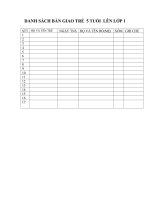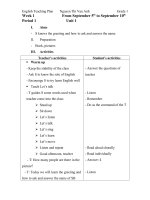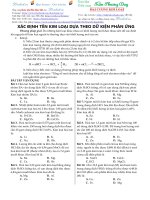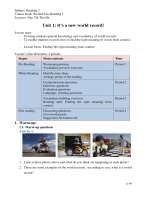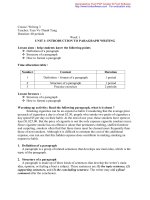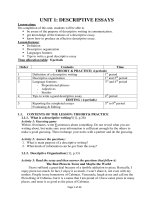Com LISTENING 5 VB2 HVLOC WEEK 1 2
Bạn đang xem bản rút gọn của tài liệu. Xem và tải ngay bản đầy đủ của tài liệu tại đây (1.13 MB, 11 trang )
EDUCATION AND TRAINING MINISTRY
LAC HONG UNIVERSITY
FACULTY OF FOREIGN LANGUAGES
LECTURES OF LISTENING 5
HOANG VINH LOC
BIEN HOA, AUGUST 2011
UNIT 1: CAREERS
Objectives and requirements
After this lesson, students can:
•
be familiar with vocabulary used in the fields of professions, recruitment
and training.
•
be familiar with TOEIC Listening: Part I. Picture Description.
•
learn the overall format of the TOEFL iBT Listening section.
Periods in class: 4
Time allocation:
No.
Content
Number
period
of
1
Target Score: Professions, Recruitment, Train.
2
2
Hooked on TOEFL iBT Listening: Overall format of
the listening section & Diagnostic test.
2
Focus:
Target Score: Professions, Recruitment, Train.
Hooked on TOEFL iBT Listening: Overall format of the listening section &
Diagnostic test.
1. Target score: Career
1. 1. Getting Ready. Choose the situation that describes what is happening in
each picture. What clues helped you decide?
1.1.1. Pair work.
With a partner, choose any of the above situations which you have been
to and talk about it.
1.2. Recruitment.
1.2.1. Language guide: Telephone calls.
Opening:
•
Peoplepower. What can I help you?
•
Hello. This is….from….Can I help you?
•
Hi, this is….speaking… What can I do for you?
Request:
•
I’m calling to….
•
Can I speak to…?
•
Can I leave a message for….?
•
Can you tell her to call me back?
•
Could you please have her call me first thing tomorrow?
1.2.1. Building your vocabulary.
Call 1. schedule department store to finalize to sort out
Call 2. HR (human resources)
deliver merchandise
Call 3. chef
temporary staff
assignment to reckon
truck driver
to involve
condition
to inform full-time to give a notice to assume
to supply a
replacement to confirm be short-staffed
1.2.2. Listening and note – taking.
Laura Alvarado is the manager of PeoplePower, a temporary work
agency. Listen to three conversations that she has with clients and fill in
the information in the table below.
Name of caller
Subject of call
Action to be taken
Call 1
(1)………. ..Jackman
2.
3.
Call 2
Howard (4)…………..
5.
6.
Call 3
Laura Alvarado
7.
8.
1.2.3. Listen and write True or False.
Listen to the conversations again and decide if these statements are true (T)
or false (F).
1.
Sabrina Marquez worked at a store during last year holiday period. __T__
The worker is completely free at the moment. _____
The man wants the worker to start work at the end of January. ______
The woman is not sure if the worker is free in January. _____
2.
The man needs to hire 2 cab drivers. ______
The drivers are supposed to deliver merchandise within the country. ____
The man and the woman are going to meet tomorrow mid-morning. ____
3.
The worker has accepted a full-time job elsewhere._____
The worker is not working so well. ______
The new chef is from Spain. ______
The man is really in need of staff. ______
2. Hooked on TOEFL iBT Listening.
2.1. Overview of the TOEFL iBT Listening Section
Listening Material
4-6 lectures
about 3-5 minutes long each.
Number of questions
Timing
6 questions per lecture
60-90
2-3 conversations,
5 questions per
about 3 minutes long each
conversation
2.2. Diagnostic Test.
2.2.1. Building your vocabulary.
minutes
•
barely
•
to show up
•
drop from
•
wait list
•
term
•
graduation requirement
•
to punish
•
a load of
•
regularly
•
circumstances
•
to skip class
•
compelling
•
on one’s behalf
•
to set aside
•
abundantly
•
dean
•
code of conduct
•
to appeal
•
to submit
•
to take a sympathetic view
•
be in high demand
•
to get right on
2.2.2. Listening and answering the questions
Listen to part of a conversation between a student and a professor.
Take note to answer the following questions.
1.
Why does the professor want to see the student?
2.
Why does the professor mention the university regulation ?
3.
What does the professor suggest that the woman do?
4.
What is the student’s opinion of the university policy?
5.
Why does the professor say this:
a/ To make sure if she really wants to take the course.
b/ To criticize her because she did not make an effort to attend the class.
c/ To give her comfort for dropping from the class.
d/ To offer a mild objection to the woman’s statement.
2.2.3. After you listen.
In groups, discuss with your classmates about your school regulations.
1)
What do you like or dislike about your school regulations?
2)
What is your school regulations about attending courses?
3)
Have you ever skipped classes? What happened to you then?
4)
In your opinion, should universities check their students’ attendance in
the courses? Why or why not?
Homework
Hooked on TOEFL iBT Listening
Listen to part of the talk in a paleontology class and answer the
questions. [page 10-11]
--
UNIT 2: WORKPLACES
Objectives and requirements
After this lesson, students can:
be familiar with vocabulary used in offices, technology and facilities.
practice TOEIC Listening: Part I. Picture Description.
practice TOEFL iBT listening: Question types 1, 2, 3.
Periods in class: 4
Time allocation:
No.
Content
Number
period
of
1
Target Score: offices, technology and facilities
2
2
Hooked on TOEFL iBT Listening: Listen for main
ideas & listen for details.
2
Focus:
Office Description - Communication at work.
TOEIC Part 1. Picture Description.
TOEFL iBT Part 1. Listening for main ideas, details, function and attitude.
1. Target score: Workplaces
1.1. Getting Ready.
Look at the pictures and name the objects you see in each picture. Then
identify the workplaces and the jobs associated with them.
1.1.1 Suggested vocabulary.
Objects
lab
Picture 1
Workplace
equipment, laboratory
bottles, containers,
Jobs
laboratory
technician
pipette, test tube,
jars, solutions
drawing,
Picture 2
drawing
ruler, architect’s
architect
board, office
model
car, tools, battery, garage,
Picture 3
engine,
mechanic
hood, workshop
fender, wheel, tire
forklift,
Picture 4
coils, pallets
stock, warehouse
forklift driver,
warehouse
worker
1.1.2. Group discussion.
1.
What different places have you worked in?
2.
What did you like/ dislike about these places?
1.2. Office working conditions.
1.2.1. The following statements are complaints from a survey of office
working conditions. Listen to ten questions (A-J). Which complaint
does each one refer to? Write your answers in the spaces provided
above.
1.2.2. Group work.
Look at the above complaints about office working conditions. Which
three would you find the most annoying? Discuss you answers with
your classmates.
1.3. Office Objects.
1.3.1. In group, look at the picture of Alison’s office. Name the objects
you can see.
1.3.2. Now listen to Alison describing her office. How many objects
could you name correctly? Add more objects to your list.
2. Hooked on TOEFL iBT Listening.
2.1. Listening for main ideas.
2.1.1.. Background.
Main idea questions test your understanding of the overall topic or main
idea of the listening passage. For conversations, you may be asked about
the main topic or the main purpose of the conversation. The main idea is the
first question after each listening passage.
2.1.2. Recognizing question types.
Main topic
Main purpose
What is the main topic of the
Why does the student visit the
lecture?
professor?
What are the speakers mainly
Why does the student visit the
discussing?
registrar’s office?
What aspect of X does the
Why did the professor ask to see
professor mainly discuss?
the student?
What problem does the woman
have?
2.1.3. Approaching main idea questions.
1.
Pay attention to the beginning of the passage.
2.
Listen for frequently repeated words or ideas.
3.
Omit answer choices that are too specific or too broad.
2.1.4. Sample questions.
Listen to part of a conversation between a student and a librarian.
1. What problem does the woman have?
a/ She lost a library book.
b/ The book she needs is on loan.
c/ The librarian does not have the book she needs.
d/ The library will not let her sign out a book.
Listen to part of a talk in an environmental science class.
2. What are the speakers mainly discussing?
a/ The damage of nuclear energy.
b/ The economic loss caused by pollution.
c/ The cost of an oil spill cleanup.
d/ The damage done by pollution.
2.2. Listen for details.
2.2.1. Background.
Detail questions test your understanding of details or facts in the listening
passage. These questions only ask about major details stated directly in the
passage. They do not ask about implied information or minor details. Some
detail questions have more that one correct answer.
2.2.2. Recognizing question types.
•
Why does the man like X?
•
What is X?
•
According to the professor, what is the main problem with X?
•
What are the functions of X? [Click on 2 answers]
•
What kind of work does the professor suggest to the man? [Click on
2 answers]
2.2.3. Approaching the questions.
Focus on major concepts: definitions of new terms, important features
of things or concepts, causes and effects of specific events, etc.
Learn the structures of conversations: What the student needs. =>
Why he or she needs it. => What the professor or university representative
will do to help the student.
Correct answer choices are often paraphrased.
2.2.4. Sample questions.
Listen to part of talk in a zoology class.
1. What is aestivation?
a/ When insects freeze during winter.
b/ When animals emerge from hibernation.
c/ When animals remain in a dormant state during the summer.
d/ When animals move slowly and eat very little in order to save energy.
Listen to part of a lecture in a chemistry class.
2. What were Marie Curie’s achievements?
Click on 2 answers.
a/ Isolating new radioactive elements.
b/ Discovering the radioactivity of uranium.
c/ Inventing the first radio.
d/ Winning two Nobel Prizes.
Homework
Listen to part I of the TOEIC test – Target TOEIC Practice Test 1.
Listen to the Pattern Drill sections on pages: 16, 17, 20 and 21. – Hooked
on TOEFL iBT Listening (Assignment – to be marked)
--

